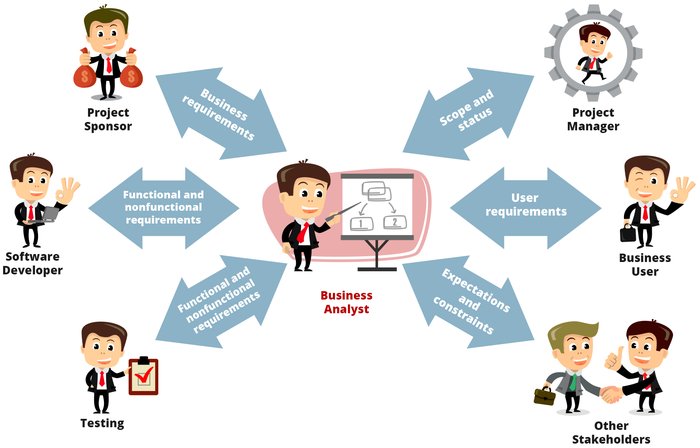
In the realm of project management, the role of a Business Analyst (BA) is indispensable. A Business Analyst acts as a bridge between stakeholders, ensuring that business requirements are clearly understood, documented, and translated into functional solutions. This dynamic interaction encapsulates the central role of a Business Analyst within a project, highlighting their crucial contribution to facilitating communication and driving project success.
Understanding Business Analysis
Business Analysis involves the identification of business needs and determining solutions to business problems. These solutions may include a software-systems development component, process improvement, organizational change, or strategic planning and policy development. The primary goal is to add value to the business by identifying opportunities for improvement and making recommendations based on thorough analysis.
Key Responsibilities of a Business Analyst
The infographic delineates the various tasks and roles that a Business Analyst undertakes in a project. Let’s break down these elements:
1. Interfacing with the Project Sponsor
The Project Sponsor is a key stakeholder who provides the financial resources and support for the project. The Business Analyst liaises with the Project Sponsor to understand the overarching business requirements. These requirements are then analyzed and documented, ensuring they align with the strategic objectives of the organization.
2. Collaborating with the Project Manager
The Project Manager is responsible for the overall planning, execution, and closing of the project. The Business Analyst works closely with the Project Manager to communicate the scope and status of the project. This collaboration ensures that the project remains on track and any issues or changes in requirements are promptly addressed.
3. Engaging with Business Users
Business Users are the end-users of the product or system being developed. Understanding their requirements is crucial for the success of the project. The Business Analyst gathers user requirements through various techniques such as interviews, surveys, and observation. This information is then translated into detailed functional and non-functional requirements.
4. Aligning Expectations with Other Stakeholders
Stakeholders, including customers, partners, and internal team members, have different expectations and constraints. The Business Analyst must manage these expectations, ensuring that all stakeholder needs are considered and addressed in the project plan. Effective communication and negotiation skills are vital in this role.
5. Guiding Software Developers
The development team relies on clear and precise requirements to build the system or product. The Business Analyst provides the functional and non-functional requirements to the Software Developers, ensuring they have a comprehensive understanding of what needs to be built. This guidance helps in minimizing errors and enhancing the quality of the final product.
6. Supporting the Testing Team
Before a product is deployed, it undergoes rigorous testing to ensure it meets the specified requirements and is free of defects. The Business Analyst works with the Testing team to validate that the developed solution aligns with the documented requirements. This collaboration helps in identifying any discrepancies early in the process, allowing for timely resolution.
The Value of a Business Analyst
The value a Business Analyst brings to a project cannot be overstated. By ensuring clear communication between all parties involved, they help in reducing misunderstandings and rework. Their analytical skills and understanding of business processes enable them to provide solutions that are both effective and efficient. Furthermore, their ability to manage stakeholder expectations and requirements contributes to the overall success of the project.
In conclusion, the role of a Business Analyst is pivotal in bridging the gap between business needs and technological solutions. Through effective communication, meticulous analysis, and collaboration with various stakeholders, they ensure that projects are delivered successfully, meeting both business objectives and user expectations. As illustrated, a Business Analyst’s involvement in every phase of the project lifecycle makes them an essential component of any successful project management team.

Comments